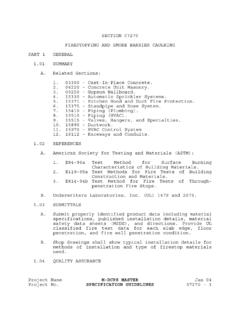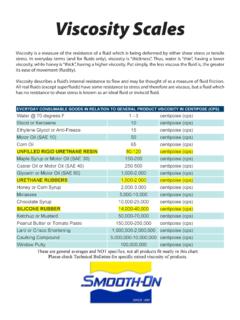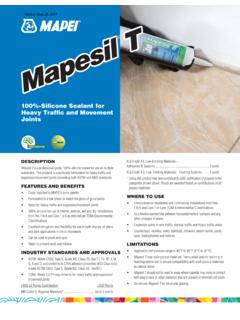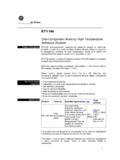Transcription of Material Safety Data Sheet NP 1™
1 Material Safety data Sheet NP 1 Version 10/28/2004 Page 1 of 6 1. PRODUCT AND COMPANY INFORMATION Company : Degussa Building Systems 889 Valley Park Drive Shakopee, MN 55379 Telephone : 952-496-6000 Emergency telephone number : (800) 424-9300 (703) 527-3887 (Outside Continental US) Product name : NP 1 MSDS ID No. : 11502 TSCA Inventory : All components of this product are included, or are exempt from inclusion, in the EPA Toxic Substances Control Act (TSCA) Chemical Substance Inventory. Canadian DSL : May contain chemicals not listed. 2. HAZARDOUS INGREDIENTS Chemical CAS No.
2 TLV STEL PEL CEIL Weight %STODDARD SOLVENT 8052-41-3 100 ppm 500 ppm - %SILICA, CRYSTALLINE QUARTZ 14808-60-7 mg/m3 mg/m3 - % 3. HAZARDS IDENTIFICATION HMIS Rating HEALTH FLAMMABILITY PHYSICAL HAZARD 2 1 0 WHMIS Class : D2B Primary Routes of Entry : Ingestion Inhalation Eye contact Skin contact Effects of Overexposure Inhalation : Inhalation of high vapor concentrations may cause symptoms like headache, dizziness, tiredness, nausea and vomiting. Inhalation of high vapor concentrations can cause CNS-depression and narcosis. Prolonged inhalation can be harmful.
3 Skin : Can cause slight irritation. May cause sensitization by skin contact. Eyes : Can cause slight irritation. Ingestion : May be harmful if swallowed. Chronic exposure : Existing respiratory or skin ailments may be aggravated by exposure. This product may contain a small amount (< ) of toluene diisocyanate. NIOSH, NTP and IARC list toluene diisocyanate as a suspected carcinogen. Note also that prolonged repeated Material Safety data Sheet NP 1 Version 10/28/2004 Page 2 of 6 exposure to isocyanates can lead to skin sensitization. For persons so sensitized even brief exposures to an isocyanate can produce reddening, swelling, rash, or blisters. Similarly, prolonged and repeated exposure to isocyanates can lead to respiratory sensitization.
4 In such individuals, brief exposures to isocyanates at levels well below established exposure limits can produce chemical asthma and nonspecific asthmatic conditions. This product contains Crystalline (quartz) Silica which has been listed as a human carcinogen by NTP (Group 1) and IARC (Human Carcinogen) and a Suspected Human Carcinogen by ACGIH (catagory A2). Repeated or prolonged over exposure to free respirable Crystalline (quartz) silica can cause silicosis or other delayed and serious lung injury. No exposure to respirable Crystalline (quartz) Silica anticipated with recommended use of product. This product contains solvents. Reports associate repeated and prolonged occupational overexposure to solvents with permanent brain and nervous system damage.
5 Reports also indicate that solvents cause liver damage, kidney damage, and mucous membrane irritation. Be warned that intentional misuse by deliberately inhaling the vapors and/or the product contents (a process often called "sniffing") can be harmful or fatal. Carcinogenicity ACGIH IARC NTP OSHA STODDARD SOLVENT No data . SILICA, CRYSTALLINE QUARTZ Suspected human carcinogen. Human carcinogen. Known carcinogen. 4. FIRST AID MEASURES Eye contact : Flush eyes with water, lifting upper and lower lids occasionally for 15 minutes. Seek medical attention. Skin contact : Remove contaminated clothing. Wash thoroughly with soap and water. If irritation persists seek medical attention.
6 Wash contaminated clothing before reuse. Ingestion : Do not induce vomiting without medical advice. If conscious, drink plenty of water. If a person feels unwell or symptoms of skin irritation appear, consult a physician. If a person vomits, place him/her in the recovery position. Never give anything by mouth to an unconscious person. Inhalation : Remove victim from exposure. If difficulty with breathing, administer oxygen. If breathing has stopped administer artificial respiration, preferably mouth-to-mouth. Seek immediate medical attention. 5. FIRE-FIGHTING MEASURES Flash point : > F ( C) Method: SETAFLASH Autoignition temperature : no data available Lower explosion limit : no data available Upper explosion limit : no data available Suitable extinguishing media : water fog carbon dioxide (CO2) foam dry chemical water spray Fire and Explosion Hazards : Fire may produce irritating or poisonous fumes.
7 Solid stream of water or foam can cause frothing. Material Safety data Sheet NP 1 Version 10/28/2004 Page 3 of 6 Special Fire-fighting Procedures : At higher temperature pressure build up in sealed containers. Use water to cool containers exposed to fire. As in any fire, wear pressure demand self-contained breathing apparatus (NIOSH approved or equivalent) and full protective gear. 6. ACCIDENTAL RELEASE MEASURES Methods for cleaning up : Ventilate the area and remove all sources of ignition. Evacuate unnecessary personnel. Take action to eliminate source of leak. Large spills should be handled carefully. Put on respiratory protection and necessary personal protective equipment. Dike or impound spilled Liquid.
8 Soak up with inert absorbent Material . Sweep up and shovel into suitable containers for disposal. 7. HANDLING AND STORAGE Handling : Keep out of reach of children. For personal protection see section 8. Storage : Keep tightly closed. 8. EXPOSURE CONTROLS / PERSONAL PROTECTION Eye protection : Wear as appropriate: Safety glasses with side-shields goggles face-shield Hand protection : Wear Chemically resistant gloves. Body Protection : Wear as appropriate: impervious clothing preventive skin protection Respiratory protection : In case of insufficient ventilation wear suitable respiratory equipment. When workers are facing concentrations above the exposure limit they must use NIOSH approved respirators.
9 Hygienic Practices : Avoid contact with skin, eyes and clothing. Ensure adequate ventilation, especially in confined areas. Wash hands before breaks and at the end of workday. When using, do not eat, drink or smoke. Handle in accordance with good industrial hygiene and Safety practice. Engineering Controls : Local exhaust ventilation can be necessary to control any air contaminants to within their TLVs during the use of this product. 9. PHYSICAL AND CHEMICAL PROPERTIES Color : pigmented Physical State : paste Odor : slight pH (at 100 %) : not applicable Material Safety data Sheet NP 1 Version 10/28/2004 Page 4 of 6 Odor Threshold : no data available Vapor Pressure : no data available Vapor Density : no data available Boiling point/range : no data available Freeze Point : no data available Water solubility : insoluble Specific Gravity : Viscosity : 4,000 - 16,000 poise Evaporation rate : Slower that ether Partition coefficient (n-octanol/water).
10 No data available VOC Concentration as applied (less water and exempt solvents) : g/l 10. STABILITY AND REACTIVITY Stability : Stable under recommended storage conditions. Conditions to avoid : Prolonged exposure to high temperatures Materials to avoid : strong oxidizing agents Hazardous decomposition products : Oxides of carbon nitrogen oxides (NOx) Hazardous polymerization : Will not occur under normal conditions. 11. TOXICOLOGICAL INFORMATION Acute inhalation toxicity Type Value Species Exposure time Product LC50 Component STODDARD SOLVENT LC50 no data available SILICA, CRYSTALLINE QUARTZ LC50 no data available Acute oral toxicity Type Value Species Material Safety data Sheet NP 1 Version 10/28/2004 Page 5 of 6 Product LD50 (Oral) no data available Component STODDARD SOLVENT LD50 (Oral) no data available SILICA, CRYSTALLINE QUARTZ LD50 (Oral) 1,300 mg/kg Acute dermal toxicity Type Value Species Product LD50 (Dermal) no data available Component STODDARD SOLVENT LD50 (Dermal)




